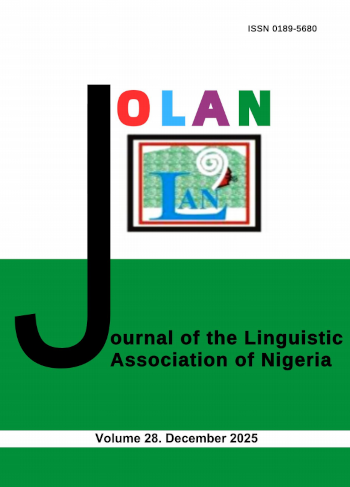Modifiers in the Structure of Yoruba Verb Phrase (VP) (Ẹ̀pọ́n nínú Ìhun Àpólà Ìṣe Èdè Yorùbá)
Keywords:
adjunct and complement modifiers, co-occurrence of modifiers, head verb, Yorùbá languageAbstract
Yorùbá
̀Ọ̀kan pàtàkì ni àpólà ìṣe (APIṢ) jẹ́ nínú ìhun gbólóhùn, kòṣeémánìí ni pẹ̀ lú. A lè ki í gẹ́gẹ́ bí ẹyọ ọ̀rọ̀tàbí àsópọ̀ ọ̀rọ̀ tí ọ̀rọ̀-ìṣe jẹ́ orí rẹ̀ tí a sì lè lò gẹ́gẹ́ bí kókó gbólóhùn nínú gbólóhùn aṣeégbà. Yàtọ̀sí ọ̀rọ̀-ìṣe tí ó jẹ́ kànńpá nínú ìhun àpólà ìṣe, a tún lè ya àwọn ẹ̀pọ́n sọ́tọ̀ tí wọ́n jẹ́ ìwọ̀fún nínú ìhun àpólà ìṣe. Ẹ̀pọ́n ni ọ̀rọ̀ tàbí àkójọ ọ̀rọ̀ tí ó ń ṣe òdiwọn ìtumọ̀ ọ̀rọ̀-ìṣe aṣorí nínú àpólà ìṣe. Àwọn ẹ̀pọ́n tí ó ń pọ́nọ̀rọ̀-ìṣe aṣorí nínú àpólà ìṣe ni ẹ̀pọ́n aṣáájú ọ̀rọ̀-ìṣe àti ẹ̀pọ́n atẹ̀ lé ọ̀rọ̀-ìṣe. A rí lára àwọn ẹ̀pọ́n wọ̀nyí tíwọ́n máa ń mú kí ìtumọ̀ ọ̀rọ̀-ìṣe aṣorí pé, àwọn ni mo pèní ẹ̀pọ́n aṣàmúpé, irú wọn jẹ́ kànńpá fùn ọ̀rọ̀-ìṣe bẹ́ẹ̀ , àwọn ẹ̀pọ́n kan máa ń fi kún ìtumọ̀ ọ̀rọ̀-ìṣe aṣorí, àwọn nimo pé ní ẹ̀pọ́n aṣàfikún, wọn kìí ṣekànńpá, ìwọ̀fún ni wọ́n fún ọ̀rọ̀-ìṣe aṣorí. A ṣàlàyé àwọn ìsọ̀rí-ọ̀rọ̀ tí a máa ń lò gẹ́gẹ́ bí ẹ̀pọ́n ọ̀rọ̀-ìṣe, ipatí wọ́n ń kó àti bí àwọn ẹ̀pọ́n ṣe máa ń jẹ yọ nínú ìhun àpólà ìṣe. Ọ̀rọ̀ atọ́nisọ́nà: ẹ̀pọ́n aṣàfikún àti aṣàmúpé, ìjẹyọpọ̀ ẹ̀pọ́n, ọ̀rọ̀-ìṣe aṣorí, èdè Yorùbá
Abstract
The verb phrase is one of the most important constituent of the sentence which a sentence cannot do without. It can be defined as a word or conbimation of words headed by a verb and used as the predicate in a grammatical sentence. Apart from the verb, which is the obligatory constituent of the verb phrase, we can also distinguish optional modifiers. A modifier is a word or phrase that specify the meaning the head verb in the verb phrase. Modifiers in the verb phrase are pre-verbal and post verbal modifiers. Some of these modifiers complement the head word, i.e. the verb, we refer to them as verbal complements, they obligatorily occur with the head verb they complement in the verb phrase. The other modifiers add to the meaning of the head verb; they are reffered to as optional adjuncts. In this paper, I explain role of these modifiers and their distribution in the verb phrase.
References
Awóbùlúyì, O. 1972. “On the Classification of Yorùbá Verb”, nínú Bámgbóṣé (olótùú) o.i. 119-134.
Awóbùlúyì, O̩ . 1978. Essentials of Yorùbá Grammar, Ìbàdàn: UPL.
Awóbùlúyì, O. 1982. “The Yorùbá Verb Phrase”, nínú Afọlayan, A. (olótùú) Yorùbá Language and Literature, Ìbàdàn: UPL and Unife Press. pp. 225-246.
Awobuluyi, O̩ . 2013. Ẹ̀kọ́ Gírámà Èdè Yorùbá. Oṣogbo: ATAM Limited
Bámgbóṣé, A. 1966. A Grammar of Yorùbá, Cambridge:CUP
Bámgbóṣé, A. 1967. A Short Yorùbá Grammar.Ibadan: HEB (Nigeria) Ltd
Bámgbóṣé, A. 1972a. “Introduction”, nínú Bámgbóṣé (olótùú) o.i. 1 - 17
Bámgbóṣé, A. 1972b. (olótùú) The Yorùbá Verb Phrase, Ìbàdàn: UPL.
Bámgbós̩ é, A. 1990. Fonó̩ ló̩ jì àti Gírámà Yorùbá. Ìbàdàn: UPL.
Taiwo, O. 2011. Mofọ́lọ́jì: Àtúnṣe kejì: Ibadan, Akada Universal Books
Taiwo, O 2014. Ìsọ̀rí Ọ̀rọ̀ Èdè Yorùbá I: Ibadan, DLC, UI
Táíwò, O. 2018a. Òṣuwọ̀n fún dídá Ọ̀rọ̀-Ìṣe mọ̀ ní Èdè Yorùbá. Bébà tí a kà ní IBALSG Colloquim, Yunifásítì Ìbàdàn. January 2018 tí a sì gbé jáde nínú JOLAN (Journal of the Linguistic Association of Nigeria) Volume 21 No 1 (2018) o.i. 76 - 96
Táíwò, O. 2018b. Àgbéyẹ̀wò Oríkì Ọ̀rọ̀-Ìṣe Èdè Yorùbá. Bébà tí a kà ní IBALSG Colloquim, Yunifásítì Ìbàdàn. July 2018
Yusuff, O̩ . 1995. Gírámà Yorùbá Àkò̩ tun: Ní Ìlànà Ìs̩ ípayà Onídàrọ, Ijebu-ode: S̩ ebiotimo̩ Publications.














